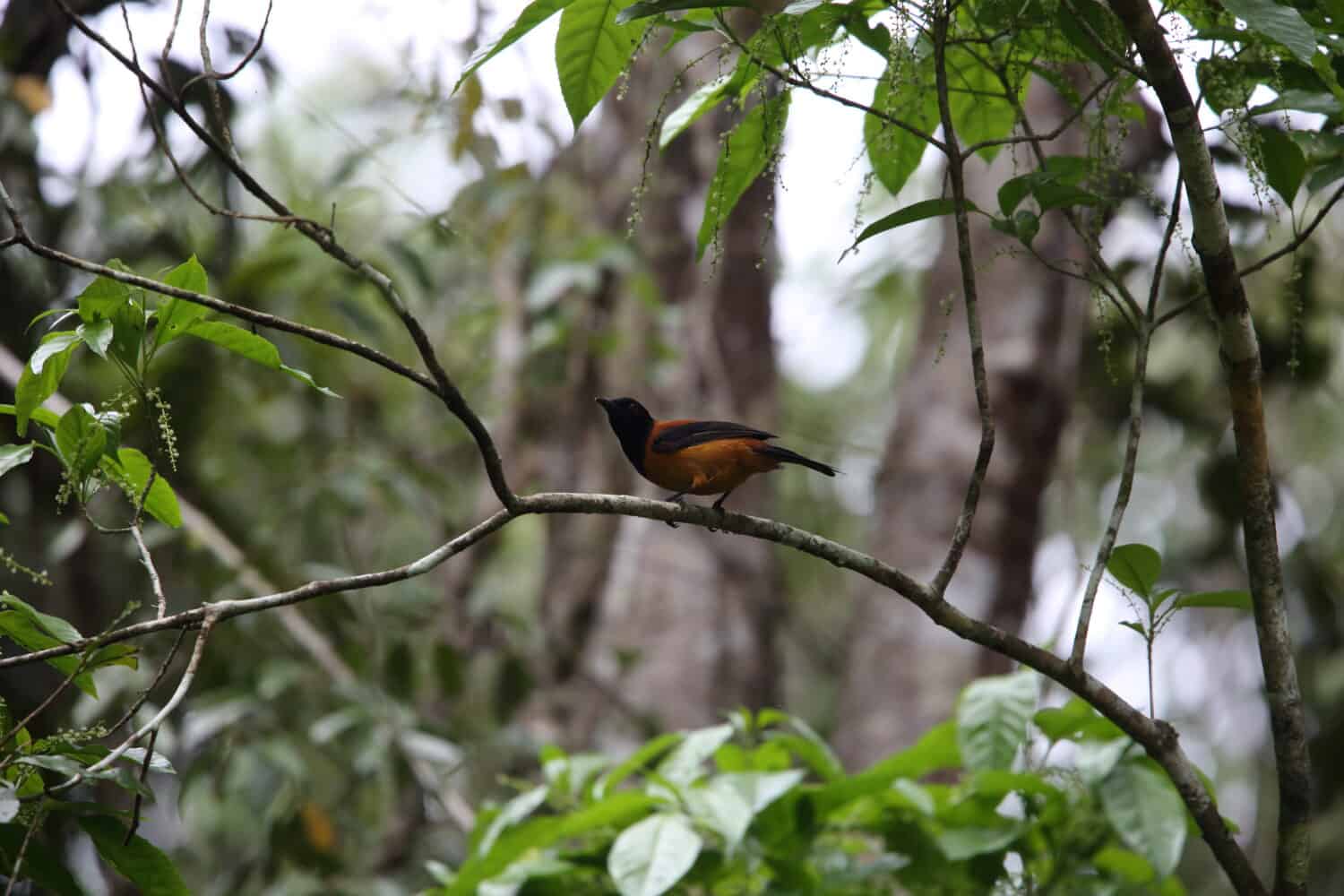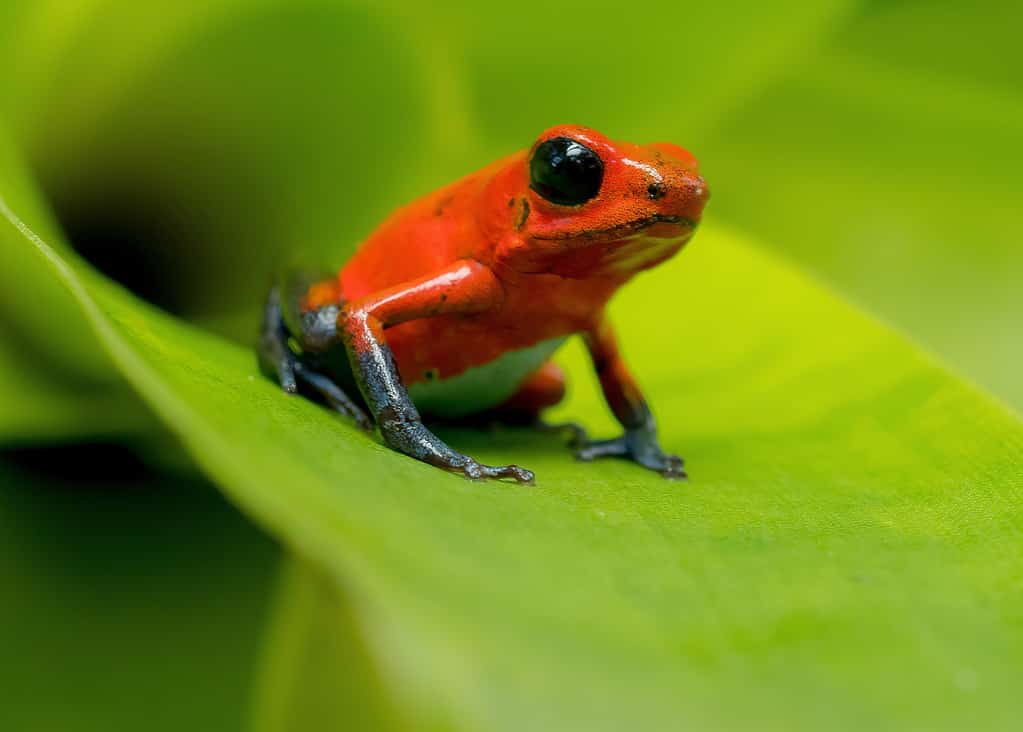Birds are known for their delightful calls and gorgeous colors, but they are rarely known to be poisonous. Despite its outlier status, the hooded pitohui is one of the most toxic birds in the world, and also one of the deadliest.
About The Hooded Pitohui

Hooded pitohui are incredibly toxic birds. They store homobatrachotoxins in their bodies.
©feathercollector/Shutterstock.com
| Scientific name: | Pitohui dichrous |
| Conservation status: | Least concern |
| Size (adult): | 8.5 to 9.2 inches |
| Location: | Indonesia |
The hooded pitohui is a medium-sized songbird from the Pitohui genus and they can be found on the islands in Indonesia- Papua New Guinea. Hooded pitohui birds were first described by French ornithologist Charles L. Bonaparte in 1850.
This monotopic bird was placed in the Pitohui genus alongside five other species and thought to belong to the Australasian Whistler family. However, they have been found to be related to the Old-World orioles, which is why the hooded pitohui belongs to the Oriolidae family and doesn’t have any subspecies.
Hooded pitohui can be found in forests around 6,000 feet from sea level, although they generally inhabit low mountains and hills. Here, these social birds form flocks and live in family groups.
Most hooded pitohuis are well-known by the people of New Guinea for having a “garbage-like” taste and smell when cooked, and they were also long regarded as toxic by the locals.
The Hooded Pitohui’s Appearance
So, what do these toxic birds look like?

Hooded pitohui birds are medium sized with an orange hood and predominantly black plumage.
©feathercollector/Shutterstock.com
Hooded pitohui aren’t very large birds, and they rarely grow over 9.2 inches in size. They are characterized by their bright orange-brown bodies, which may indicate to predators that they are toxic. They also have black wing, tail, and head feathers. The black plumage may also have a blueish-green or brownish sheen in certain lighting. Their legs are slender and typically black or dark grey. Most hooded pitohui rarely weigh more than 2.7 ounces.
How Was the Hooded Pitohui Found to Be Toxic?
At first glance, the hooded pitohui bird looks harmless. However, they are one of the first birds to be recorded as poisonous or toxic. Out of all passerine birds that were tested in New Guinea, the hooded pitohui was the most toxic. This is because hooded pitohui stores homobatrachotoxins in their bodies. This is the same neurotoxin that can be found in some species of beetles and frogs.
An ornithologist, Dr. Jack Dumbacher experienced firsthand what the toxins could do after he came into contact with these birds captured in netting. After pricking his finger on one of the feathers, Dumbacher reflexively put his finger in his mouth to alleviate the pain. Shortly after this, his mouth began to go numb and burn.
Although he already suspected his numbness and pain were caused by the bird, he tested his theory by placing a feather in his mouth. Soon, he felt the same sensations he had felt before. After speaking with the locals who confirmed the bird to be poisonous, Dumbacher planned to learn more about this bird and its toxins.
After countless research projects, he concluded that the hooded pitohui stored homobatrachotoxins in its feathers, skin, and internal organs. However, these toxins were highest in the feathers and skin. This makes the bird toxic to the touch, resulting in symptoms of numbness, tingling, and burning. These symptoms can last for a few hours and be incredibly uncomfortable. If you were to ingest this poisonous bird, you may experience paralysis and even death. However, the hooded pitohui doesn’t have a high concentration of these toxins in comparison to the poison-dart frog, which is why the poisoning experience can be milder.
Batrachotoxins in Birds
Surprisingly, hooded pitohui don’t create their own homobatrachotoxins (from the batrachotoxins class) but rather gets them from their diet. The hooded pitohui primarily feeds on fruit, grass seeds, and small invertebrates like beetles, including Melyrid family beetles in the Choresine genus. These beetles contain the toxins that make the hooded pitohui’s body poisonous to touch and consume. These homobatrachotoxins can also be found in the poison-dart frog, which secretes the deadly toxins in high amounts.
When the hooded pitohui eats the Melyrid beetles, the homobatrachotoxins are stored in different parts of the bird’s body. Interestingly, these toxins don’t harm the bird. This is believed to be due to a toxin sponge or proteins that could prevent the fatal toxins from causing damage to the hooded pitohui’s body.
The neurotoxic steroidal alkaloid homobatrachotoxin possibly functions as a chemical defense in the bird, which could be an adaptation for better survival in the animal kingdom. These homobatrachotoxins could help the hooded pitohui deter predators and pests like lice, and when burnt, make the hooded pitohui taste and smell horrible. However, the exact reason for the hooded pitohui’s homobatrachotoxins isn’t fully understood yet.

Strawberry dart frogs from the Dendrobatidae family have potent batrachotoxins in their skin.
©Pavel Russe/Shutterstock.com
Conclusion
While batrachotoxins were usually associated with certain beetles and poisonous frogs, the hooded pitohui has proven that’s birds may have evolved to handle homobatrachotoxins.
Researchers continue to study and test different theories on the homobatrachotoxins in the hooded pitohui. The way that the bird’s body protects itself from the fatal toxins could give researchers important insight into biological systems.
The photo featured at the top of this post is © feathercollector/Shutterstock.com
Thank you for reading! Have some feedback for us? Contact the AZ Animals editorial team.






